I’m not angry. I’m just disappointed.
Daniel, my guide for the week at Turneffe Flats in Belize didn’t say it, but it was written all over his face. By all rights, he should have been disgusted. Getting two chances at the same permit or group of permit can be rare. Getting a dozen or possibly even more is unheard of.
Had Daniel been angry, it would have been understandable. Well earned, even. And like an adolescent boy being rebuked by his parents, I would have taken it in stride, recycled it with a mixture of my own frustration and returned the sentiment. But this was worse. After a week of hard work during which Daniel delivered on everything I had asked for, when it came time for me to deliver on the permit we’d been in search of for five days, I was letting him down. Repeatedly.
It is likely fair to say that permit, much like steelhead, are earned rather than simply caught. Both involve long, searching days on the water, hoping for an encounter but — more often than not — failing to spark one. When a shot at a permit does come, you don’t waste it. Not ever.
Guides know this better than most anyone else and this knowledge generally comes through in their behavior. There’s more than a heightened sense of urgency when permit are about. When that black sickle tail comes into view, everyone gets down to business. Casual conversation and cavalier attitudes are pushed aside.
Often, politeness is too. I’ve had guides that would otherwise maintain decorum snap at me for blowing a cast, heard profanity spouted from the poling platform after getting an eat and missing the hook set, had disgusted looks thrown my way for stupidly breaking off a solidly hooked fish on light tippet. This behavior isn’t only understandable, it’s perfectly acceptable. The guide wants that fish as much as you do. Maybe more.
Plus, I’m not a thick-skinned client. It doesn’t bother me in the least when my guide tells me I’ve cast too long, too short, aimed poorly or have simply gotten it all wrong. I’m there to learn. I want to be corrected. Most often, guides are happy to oblige. Many even seem genuinely happy to have an eager student on the bow and everyone on the same page. Questions and answers are thrown about, well-intentioned insults are tossed back and forth. It’s a good dynamic.
Recently while traveling, I overheard a fellow angler explaining to his guide that he had “paid a lot of money” to be there and thus expected “to be yelled at. A lot.” The comment was partially tongue-in-cheek, but there was a fair measure of honesty to it and one that I had no trouble relating to. I’m the same way. I don’t want my guide to coddle me or inflate my ego. I want my guide to instruct me, help me follow his instructions, and take me to task when I fail to.
On my last day on the Turneffe Atoll, I was failing in virtually every conceivable way.
Permit hunting at Turneffe Flats can be much like permit hunting anywhere else, poling or wading sun-dressed, seemingly endless sand flats in search of tails and hoping to get in position for a cast when fish are spotted. But it can also be very different, offering unique opportunities that can’t be had many other places.

In the interior of the Turneffe Atoll, there is a lagoon that is often frequented by permit. Fish found there typically travel in greater numbers than those found on the flat. Permit are more commonly spotted in groups of five or 10 than they are in groups of two or three.
The waters of the lagoon are a bit deeper and the sea floor is more densely vegetated than your average permit flat, making spying tails more difficult. Fish are spotted by looking for pushes of water rather than tails, and is done by trolling the lagoon’s edge where it meets the mangrove, much like running a lake shore in search of largemouth bass.
To be clear, this is not casting at cruising schools of permit in blue water, which is a wholly different and less gratifying experience. These fish are feeding — and often tailing — on crabs and shrimp in the turtle grass, just as they do on a typical sand flat. This is classic permit fishing, once you’ve found them. Only there’s more of them to be found.
As we set out that day, I almost pulled the plug on our search of the lagoon. Despite the bounty of permit that frequent the atoll, throughout the course of the week we had spied only one which barely gave us a glance let alone a shot. Our daily scoutings of the lagoon, normally a dependable locale, hadn’t offered up anything. And so with heavily overcast skies above and plenty of fat bonefish around to be caught, the aching urge to put a permit in the boat was waning. We had put our time in, it just wasn’t happening, which is often the reality of permit fishing.
At Daniel’s urging, we agreed to take one last look. Instead of contributing my inferior eyes to the search, I opted to relax and soak up the wallpaper instead. It had been a very good week — full of bonefish, barracuda, jack crevalle and even a boxfish — despite the lack of permit. And so I didn’t want it that bad anymore.
But just as the weight of my permit desire was lifting, they were there. Daniel spotted a group of permit feeding on the edge of the mangrove, at least two hundred yards further away than my eyes could have spied them. They were 8 fish. Maybe 12.
We made a careful approach with the boat, leaving the fish undisturbed, and watched as sickle tails intermittently poked from the lagoon’s dark surface, made even more shadowy by the increasingly black skies above. Unlike most permit shots, this one wasn’t hurried. We watched as the permit fed merrily while we discussed the plan and set to execute it.
My first few casts fell short. I played each cast carefully, stripping the heavy crab slowly as if it had been on target, hoping to catch the eye of an eager fish and get an eat. My next attempt, an overcorrection, plopped down in the midst of the group, sending permit fleeing in every direction.
That should have been it.

Instead, the fish reassembled a few hundred yards down the shore, which I wouldn't even have noticed had I been on the water alone. The fish had fled in multiple directions, most into the deeper and darker waters of lagoon where it strayed from the mangrove, and had disappeared from my view. Daniel, however, was somehow able to spot the individual fish and track them, watching them coalesce to feed again.
We chased in the boat, made another careful approach and I found myself back at the plate, hoping to perform better this time around. But the situation played out largely the same. One cast too short, one too long and then the fish were gone.
That second, entirely separate opportunity was a tremendous gift, one I didn't presume we'd receive again. But we did. The fish, once again, reunited farther down the line of mangroves and we chased. This time I put two casts on target, but failed to get an eat. We took off the pale bodied crab fly we’d been fishing in favor of a rusty-colored, heavier shrimp pattern. My first cast came down on the edge of the fish, but I let the heavy fly come down too hard. The presentation splattered seawater on the surface and sent the fish fleeing once more, this time presumably for good.
Another encore. Again they gathered within sight in the lagoon — this time in the opposite direction — and we chased. Again Daniel offered targets. Again I missed them. Again the fish fled.
Daniel had patiently delivered at least a dozen shots at happily feeding permit to an angler capable of making them and we had nothing to show for it, mostly due to poor execution on my part. And that’s when I saw the look on his face. Instead of the reproach or condemnation I had become accustomed to during my time spent permit fishing with other guides, there was just that look of disappointment. A sarcasm-laden "nice job", or indignant line of questioning would've taken the sting out of it, but there was none of that. There was just that look of defeat, as if he had been tasked with hammering a nail into a piece of teak with a tomato.
Determined to put an end to the ongoing calamity, my permit lust returned, and I hoped that the willing fish we had discovered — possibly the most cooperative permit in the entire Caribbean — would give us one more shot, despite the fact that I sorely didn't deserve it.
We watched hopefully as the group moved again into the deeper waters of the lagoon, this time holding there for a period of time. Before long, they returned to the mangrove’s edge one more time and we pursued yet again.
This time, my first cast was on target and an eager fish on the edge of the group snatched it up greedily. The permit put on its show, peeling line and showing backing over the course of several determined runs. As the fish ran and we discussed the events leading up to the eat, there was as much a sense of relief in the boat as there was one of excitement. When it finally came to the boat, it wasn’t one of the larger fish we had spied in the group, which we guessed to be somewhere around 30 pounds, but it was an energetic, impressive fish that might have approached 20.
Most importantly, that look of disappointment on Daniel's face was gone. Plus, we had that permit.




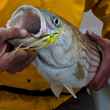












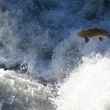




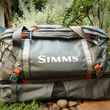



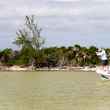
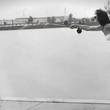

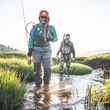
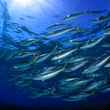
Comments